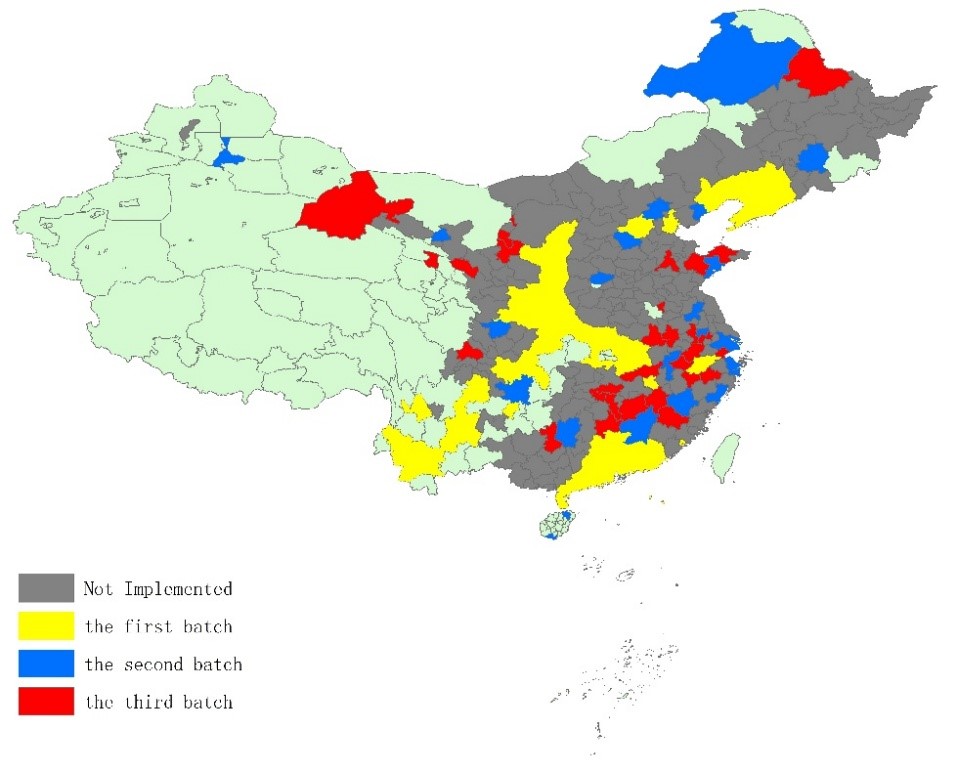Evaluation of the Policy Effects of Low-Carbon City Pilot Projects Based on the PSM-DID Model
Abstract
In the context of the dual-carbon policy, evaluating the implementation effects of low-carbon city pilot policies is of great significance. Based on panel data from 284 prefecture-level cities in China between 2004 and 2020, this paper integrates the Propensity Score Matching (PSM) method with the Difference-in-Differences (DID) method, referred to as the PSM-DID model. By employing parallel trend tests, placebo tests, robustness checks, and heterogeneity analyses, the implementation effects of the low-carbon city pilot policies are evaluated and compared with those from the traditional DID model. The results indicate that: (1) The low-carbon city pilot policies significantly curb carbon emissions in eastern China, while the effects in central and western regions are relatively weak; (2) Factors influencing carbon emissions differ significantly across regions. In particular, clean energy structure and per capita affluence have a greater impact on the eastern region, while the effect is weaker in the central and western regions; (3) The timing, scope, and regional factors of implementation significantly affect the policy outcomes. Policies implemented early yield more significant results than those implemented later, with regional development levels and scope of implementation playing key roles in shaping policy outcomes; (4) The PSM-DID model yields more reliable results than the DID model.
References
Chengying, L., & Jianping, L. (2022). Policy effects, emission reduction paths, and insights for carbon peak in low-carbon pilot projects: Based on PSM DID test of 275 cities in China. Journal of Hubei University (Philosophy and Social Science), 49(6), 159-168. https://doi.org/10.13793/j.cnki.42-1020/c.2022.06.015
Chuang, L., Zhijia, W., & Liping, W. (2023). The impact of carbon emission trading policy on firms' green technology innovation: Based on instrumental variables and triple difference test. Science of Science and Management of S.& T., 44(5), 15-33.
Jing, Z., Jun, S., & Meng, X. (2023). Does carbon emission trading promote the transformation and upgrading of industrial structure? Empirical evidence from China’s carbon emissions trading pilot policy. On Economic Problems, 2023(8), 84-91. https://doi.org/10.16011/j.cnki.jjwt.2023.08.010
Ju, X., Zhao, X., & Sun, B. (2020). Internet and trade costs: An empirical analysis based on cross-border e-commerce data from China SME exports. Economic Research Journal, 55(2), 181-196.
Lin, Y., Shen, Y., & Sun, A. (2020). Evaluating the stimulus effect of consumption vouchers in China. Economic Research Journal, 55(7), 4-20.
Qi, S., & Jiaqi, L. (2024). The impact of national-level strategic emerging industry clusters on the high-quality development of cities: An empirical study based on PSM-DID. Modern Management Science, 2024(1), 44-54.
Qiao, W., & Shuo, S. (2020). Green growth effect assessment of Chinese low-carbon pilot from the perspective of urban heterogeneity. Soft Science, 34(9), 1-8. https://doi.org/10.13956/j.ss.1001-8409.2020.09.01
Qilin, M., & Jiayun, X. (2014). Whether the outward foreign direct investment of Chinese enterprises has promoted enterprise innovation or not. The Journal of World Economy, 37(8), 98-125. https://doi.org/10.19985/j.cnki.cassjwe.2014.08.006
Qing-feng, C. (2020). Driving effects of national new zone on regional economic growth: Evidence from 70 cities of China. China Industrial Economics, 2020(7), 43-60. https://doi.org/10.19581/j.cnki.ciejournal.2020.07.014
Shenxiang, X., Pengfei, F., & Yuanyuan, W. (2021). Improvement and application of classical PSM-DID model. Statistical Research, 38(2), 146-160. https://doi.org/10.19343/j.cnki.11-1302/c.2021.02.011
Siyu, Z., & Bing, Y. (2023). Research on the co-benefits of pollution reduction and carbon reduction of “emissions trading” and “carbon emissions trading”: Based on the dual perspectives of pollution control and policy management. Chinese Journal of Environmental Management, 15(1), 102-109. https://doi.org/10.16868/j.cnki.1674-6252.2023.01.102
Song, Y., Chen, X., Li, Z., Zeng, Z., & Zhang, M. (2022). Exploring the effect of a low-carbon city pilot policies on carbon dioxide emission intensity: Based on the PSM-DID method. Chinese Journal of Population, Resources and Environment, 20(3), 209-216. https://doi.org/10.1016/j.cjpre.2022.09.001
Wang, H., Chen, C., Xiong, Z., & Li, D. (2023). How to achieve carbon neutrality in cities? Evidence from China’s low-carbon cities development. International Journal of Environmental Research and Public Health, 20(3), 2121. https://www.mdpi.com/1660-4601/20/3/2121
Weibing, L., & Kaixia, Z. (2019). The impact of air pollution on firm productivity: Evidence from Chinese industrial firms. Journal of Management World, 35(10), 95-112+119. https://doi.org/10.19744/j.cnki.11-1235/f.2019.0134
Xu, A., Song, M., Wu, Y., Luo, Y., Zhu, Y., & Qiu, K. (2024). Effects of new urbanization on China's carbon emissions: A quasi-natural experiment based on the improved PSM-DID model. Technological Forecasting and Social Change, 200, 123164. https://doi.org/10.1016/j.techfore.2023.123164
Yang, H., Gan, T., Liang, W., & Liao, X. (2022). Can policies aimed at reducing carbon dioxide emissions help mitigate haze pollution? An empirical analysis of the emissions trading system. Environment, Development and Sustainability, 24(2), 1959-1980. https://doi.org/10.1007/s10668-021-01515-9
Yan-ping, Z., Jing, L., & Hui-ying, C. (2024). The impact of clean energy demonstration provincial policies on carbon emissions and economic development in pilot areas: Verification based on multi-phase PSM-DID. Soft Science, 38(1), 53-60+82. https://doi.org/10.13956/j.ss.1001-8409.2024.01.08
Yi, L., Zhihui, L., & Zhixiang, G. (2017). Individual tax reform of marriage matching, intergenerational mobility and family pattern. Journal of Management World, 2017(9), 60-72. https://doi.org/10.19744/j.cnki.11-1235/f.2017.09.006
Yijun, L., Yanan, W., & Yuan, C. (2023). The impact of the industrial internet on the digital transformation of manufacturing enterprises: Verification based on multi-time point PSM-DID. Enterprise Economy, 42(8), 83-92. https://doi.org/10.13529/j.cnki.enterprise.economy.2023.08.008
Ying, M., Mengjie, Q., & Lizhen, Z. (2022). Regional emission reduction effect of carbon emissions trading pilot: Based on PSM-DID model. Science Technology and Industry, 22(5), 235-240.


This work is licensed under a Creative Commons Attribution 4.0 International License.
Copyright for this article is retained by the author(s), with first publication rights granted to the journal.
This is an open-access article distributed under the terms and conditions of the Creative Commons Attribution license (http://creativecommons.org/licenses/by/4.0/).
























